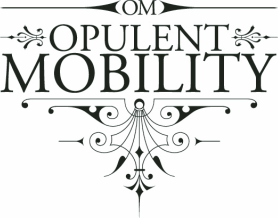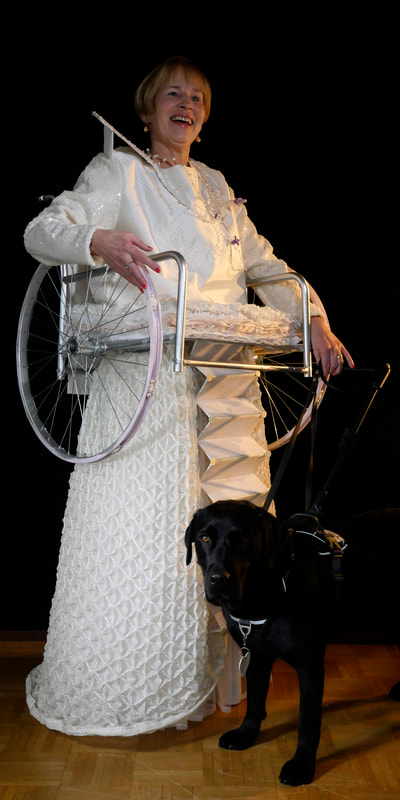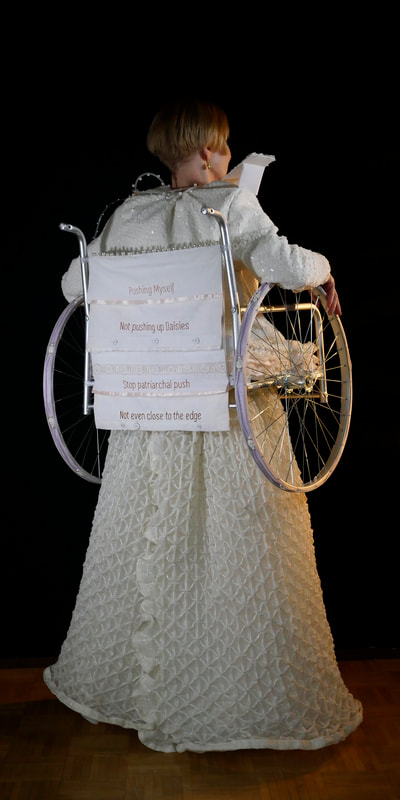Jenni-Juulia Wallinheimo-Heimonen
Am I Your Inspiration Really? (Diptych)
2021
Photographic prints
48" x 24"
$375 each
Website: http://www.kolumbus.fi/jenni_juulia/
Finland
Modeled by Counsellor of Social Welfare Sari Loijas and her guide dog Citta
VO by Mari Weiss
2021
Photographic prints
48" x 24"
$375 each
Website: http://www.kolumbus.fi/jenni_juulia/
Finland
Modeled by Counsellor of Social Welfare Sari Loijas and her guide dog Citta
VO by Mari Weiss
ABOUT THE ARTWORK:
“Am I your inspiration, really?” is a statement against hypocrisy and discrimination framed as kindness. If we people with disabilities are really so cool, why would the most common symbol of ours - the wheelchair - not be part of an evening gown for walking people as well?
STATEMENT:
As a political disability artist all of my artwork deals with kindness, discrimination, structural violence, human rights, and design which maintain the low status of disability. I’m especially intrigued by the culture of "aboriginal" persons with disabilities; people who are born with their piquant features. I come from a family which has a history of four generations of visual impairments from my father’s side and a history of four generations of brittle bones disease on my mother’s side. All my life I have seen my relatives solving challenges and acting in unconventional ways. This life style that physically privileged people see as adaptation, extreme courage or surviving represents for me a refined and cultured disability. People with inborn impairments don't have a sensor that constantly monitors how we differ from imaginary norms. Questioning being defined as anomalies by outsiders is important for our identity. In science fiction it's predicted that technologically advanced societies will someday be able to get rid of disability. The media leads the general public to believe that no one would choose to live with a disability or give birth to a disabled child if there was a choice. Disability is treated as something horrifying that needs to be avoided. But actually it arises in social relations, from the environment and our reactions to impairments.
Globally, even in Finland, people with disabilities often don´t understand what kind of rights we have. Discrimination that is produced by culture, by human perceptions, and by inaccessible environments runs so deep. Charity and human rights often get mixed up in decision-making. Setting things right is a value judgment; all the knowledge and technology for doing so already exists.
For me, disability as a concept doesn’t mean defective individuals but the way people are treated whose features differ from imaginary norms. This phenomenon does not disappear, even though we manipulate bodies or genes and change them. Tampering with individual features does not eliminate discrimination. To increase overall eudaimonia in this world, we should find smarter ways to change attitudes and structures around the whole concept of well-being. This is what I try to do through my art.
Globally, even in Finland, people with disabilities often don´t understand what kind of rights we have. Discrimination that is produced by culture, by human perceptions, and by inaccessible environments runs so deep. Charity and human rights often get mixed up in decision-making. Setting things right is a value judgment; all the knowledge and technology for doing so already exists.
For me, disability as a concept doesn’t mean defective individuals but the way people are treated whose features differ from imaginary norms. This phenomenon does not disappear, even though we manipulate bodies or genes and change them. Tampering with individual features does not eliminate discrimination. To increase overall eudaimonia in this world, we should find smarter ways to change attitudes and structures around the whole concept of well-being. This is what I try to do through my art.
DESCRIPTION:
Am I Your Inspiration Really?
A smiling woman with short, straight blonde hair and bangs wears a white blouse and floor length skirt. The top has long sleeves embellished with white sequins and the international disability symbol stitched in white thread and beads on the chest. She also wears a necklace of IV tubing with purple valves adorned with scattered pearls. A small wheelchair is incorporated into the blouse and its back touches her back. The push handles stick out behind her. The blouse has a slightly flared square hem that rests on the chair seat. Beads and sequins trim the layers of the hem. Her right hand lays on the rear wheel which is trimmed in ribbon and tiny pearl beads. A panel of accordion pleats falls from below the seat in a stair-step like manner. Some of the skirt hem is pulled up and attached to the panel revealing a sheer petticoat. The skirt is quilted with a raised diamond pattern. At the woman’s feet to her left is a black guide dog on a lead.
On the back of the woman’s gown, four panels are attached to the chair back that read:
Pushing Myself. Not pushing up Daisies. Stop patriarchal push. Not even close to the edge.
-description by Teri Grossman
A smiling woman with short, straight blonde hair and bangs wears a white blouse and floor length skirt. The top has long sleeves embellished with white sequins and the international disability symbol stitched in white thread and beads on the chest. She also wears a necklace of IV tubing with purple valves adorned with scattered pearls. A small wheelchair is incorporated into the blouse and its back touches her back. The push handles stick out behind her. The blouse has a slightly flared square hem that rests on the chair seat. Beads and sequins trim the layers of the hem. Her right hand lays on the rear wheel which is trimmed in ribbon and tiny pearl beads. A panel of accordion pleats falls from below the seat in a stair-step like manner. Some of the skirt hem is pulled up and attached to the panel revealing a sheer petticoat. The skirt is quilted with a raised diamond pattern. At the woman’s feet to her left is a black guide dog on a lead.
On the back of the woman’s gown, four panels are attached to the chair back that read:
Pushing Myself. Not pushing up Daisies. Stop patriarchal push. Not even close to the edge.
-description by Teri Grossman
DONATE via Fractured Atlas!

Opulent Mobility by A. Laura Brody is licensed under a Creative Commons Attribution-ShareAlike 4.0 International License
The Opulent Mobility license refers to the exhibit and its audio descriptions. Individual artworks are the property of the individual artists.



